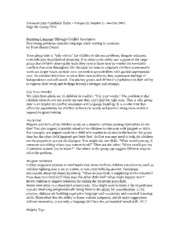
ERIC EJ726876: Building Language Through Conflict Resolution: Discussing Problems Enriches Language While Leading to Solutions PDF
Preview ERIC EJ726876: Building Language Through Conflict Resolution: Discussing Problems Enriches Language While Leading to Solutions
Scholastic Early Childhood Today – Volume 20, Number 3 - Nov/Dec 2005 Page 48 Group Time Building Language Through Conflict Resolution Discussing problems enriches language while leading to solutions by Ellen Booth Church Your group time is “talk central” for children to discuss problems, imagine solutions, even role-play hypothetical situations. It is often in the safety and support of the large group that children develop the tools they need to learn how to resolve the inevitable conflicts that arise throughout life. Because we want to empower children to eventually work out larger issues on their own, we need to provide them with guided opportunities now. As children learn how to solve their own problems, they experience feelings of independence and self-worth. Vocabulary grows and children’s confidence in their ability to express their needs and feelings becomes stronger and stronger. Use Your Words! We often hear adults say to children in conflict, “Use your words.” The problem is that children often do not use words because they can’t find the right ones. That is why group time is so helpful for conflict resolution and language building! It is a calm time that offers the opportunity for children to learn the words and practice using them within a supportive group setting. Act It Out Puppets and dolls allow children to try on a situation without putting themselves on the line! You can suggest a specific situation for children to role-play with puppets or dolls. For example, one puppet could be a child who wanted to sit next to the teacher for group time but the other child (puppet) got there first. At first you may need to help the children use the puppets to act out the dialogue. You might ask one child, “What would you say if someone was sitting where you wanted to sit?” Then ask the other, “What would you say if someone wanted you to move?” The others in the group can suggest different ways to solve the problem. Imagine Solutions Collect magazine pictures or read books that show conflicts children can relate to, such as children fighting over a toy or a trike, or one child bullying another. Encourage discussions about the issues by asking, “What do you think is happening in this situation? How does this child feel? How does the other child feel? What might happen next?” Invite children to suggest solutions for ending the situations peacefully. Issues arise daily in a classroom commu-nity. You might want to make a list of problems you are observing and periodically bring these to the group for consideration. In the process, children are building expressive language and vocabulary and essential listening skills. Remember that the ability to listen without judgment, and to make suggestions without ownership, is not only a language skill but also an essential social skill. ECT Helpful Tips: Use these tips to help children take turns and listen respectfully to one another: • We all know that when we ask children to raise their hands for a turn, they often keep talking while they have their hands raised! Show children how to raise one hand while placing their first finger of their other hand up to their mouths in the “shhhh” signal. • It is also helpful to reward those who are waiting quietly for a turn instead of the child who is wildly waving his hand, saying, “Oooh, oooh, I know, I know!” While it can be difficult to ignore this behavior, it is also surprisingly effective when you do. You can say, “I will call on someone who is raising his hand quietly. Thank you, Ralphie, for waiting quietly. It’s your turn to talk.” Children quickly learn that, if they want to be rewarded with a turn, they have to use the same behavior. • Teach turn-taking with a simple game. Use a small, soft ball. Explain that the ball is a “talk” object, and the child holding the toy can talk while the rest listen. After answering the question, the child rolls the ball back to the teacher, who then rolls it to another child who has an answer to the question. Ellen Booth Church is a consultant and the author of Best-Ever Circle Time Activities: Month by Month.
